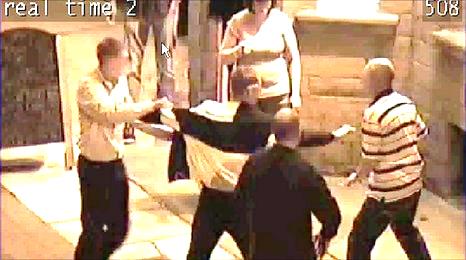How do people decide who to intervene towards in street conflicts?

Imagine that you are walking down a street and two individuals start to fight. Many of us want to believe that we would intervene and help in this kind of situation. But helping can be challenging - fights are often fast paced and can appear chaotic. There is oftentimes not a clear division between who is the victim and who is the perpetrator. This means that after deciding to do something we still have to make sense of the situation and figure out who to intervene towards – we have to decide who we try to stop.
Video footage of real-life conflicts from the streets of Amsterdam
In order to investigate this, NSCR researchers analyzed video footage of real-life conflicts from the streets of Amsterdam, collected in collaboration with the Municipality of Amsterdam and the Dutch Police. This footage allowed them to investigate how real-life conflicts play out and see how real people make decisions in the heat of the moment. Many of these decisions are quick and can be difficult to recollect afterwards. The use of video footage thus offers a glimpse into a world otherwise difficult for researchers to access.
Preconceptions in who people intervene towards
Based on the analysis of the videos, they found that people who try to de-escalate a conflict have certain preconceptions in who they intervene towards - and this is after the researchers have controlled for the aggressiveness of the conflict parties. First, they see that the people who intervene are more likely to try to stop someone they know rather than strangers. If their friend is getting involved in a conflict with a stranger, they are thus more likely to stop their friend than the stranger. Furthermore, the people who intervene in a conflict also have a gender preconception. In a conflict between a man and a woman, where they have both been equally aggressive towards each other, they are more likely to try to stop the man than the woman.
Peace keeper might be able to de-escalate conflict, but is not necessarily fair
When a fight breaks out there is rarely police or other professional guardians present to handle the conflict. Previous research argues that ordinary people present in the situation are another resource for conflict de-escalation. In this study, the researchers argue that these ordinary peace keepers might be able to de-escalate the conflicts, but that they are biased in the way they handle the conflicts. They take responsibility for their friends and try to stop them from continuing to engage in the conflict. They also find that these ordinary people have a gender bias in the way they intervene. While these interveners thus might be a resource for conflict de-escalation, they are not necessarily fair in the way they act.
Publication details and further reading
Ejbye-Ernst, P., Lindegaard, M.R. & Bernasco, W. (2020). A CCTV-based analysis of target selection by guardians intervening in interpersonal conflicts. European Journal of Criminology.
Actuele berichten

